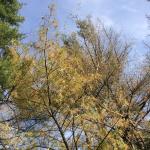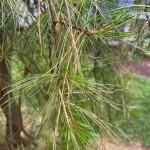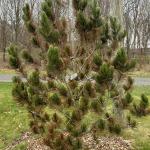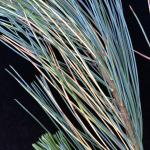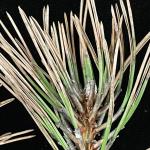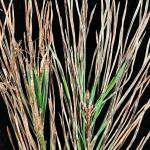Brown Spot Needle Blight
Pathogen
Brown spot needle blight (BSNB) is caused by the fungal pathogen Lecanosticta acicola (formerly Mycosphaerella dearnessii). This fungus is native to North America.
Hosts
Eastern white pine (Pinus strobus) is the primary host in New England, but numerous five-, three- and two-needle pines are also infected. Based on samples submitted to the UMass Plant Diagnostic Laboratory, additional hosts in southern New England include (but are not limited to): Japanese red pine (P. densiflora), limber pine (P. flexilis), mugo pine (P. mugo), Austrian pine (P. nigra), Scots pine (P. sylvestris), and Japanese black pine (P. thunbergii). Lecanosticta acicola is distributed widely throughout the northern hemisphere, attacking pines in North America, Europe and Asia. For a broader list of known hosts, see Sinclair and Lyon (p. 26; 2005).
Symptoms and Disease Development
White pine needle damage (WPND) was first documented in 2009 and is a chronic stress for eastern white pines throughout eastern North America (Broders et al. 2015). Symptoms of infection by Lecanosticta often first appear as yellowing to browning of older needles in late spring and early summer. Once these symptoms develop, diseased needles are quickly shed from the canopy. Symptoms can also appear as brown, blighted needle tips. In these cases, needles may be retained in the canopy for longer periods of time as the base remains green. Studies and surveys have concluded that L. acicola is one of two fungi (along with Septorioides strobi) primarily responsible for WPND in the northeast (Broders et al. 2015, Wyka et al. 2018).
BSNB can first develop in the lower or interior canopy where shade and moisture is abundant. Historically, lower canopy branches and small trees were most susceptible (Sinclair and Lyon 2005), but since the WPND outbreak started in 2009, mature trees are diseased throughout the entire canopy. Research has shown this increase in disease incidence and severity is due to a change in regional climate that has created ideal conditions for disease development (Wyka et al. 2017). Specifically, mild temperatures, high overnight humidity and a higher frequency of rain events from May through July are stimulating disease development. The spores of L. acicola can germinate and infect pine needles only when they are wet and the pathogen largely goes dormant during extended dry periods. Therefore, the higher frequency of rain events during the spring and early summer, when newly developing pine needles are most susceptible to infection, is a driving force in the WPND epidemic.
Spores of L. acicola are dispersed by rain and wind from older, diseased needles to the developing, current season's needles in late spring and early summer (Sinclair and Lyon 2005). Peak fungal spore dispersal coincides with peak needle shedding, which takes place between mid-May to mid-June in southern New England. On eastern white pine, once the current season’s needles are infected, they often remain free of symptoms for many months. Symptoms of the disease can be first detected in autumn to winter as tan-brown or reddish-brown foliar lesions, primarily at the needle tips. However, necrotic spots can also appear in the middle and lower sections of the needles. Needle tips often die back to the spot of the lesions until they completely die later on. Symptoms may develop sooner on two- and three-needle pines, especially if trees are stressed. In the late spring and early summer – nearly one year after infection – needles become yellow to straw-colored and are prematurely shed from the canopy (Sinclair and Lyon 2005). Older needles are shed in large numbers when new growth is still developing, giving trees are very thin and weak appearance. Once the new growth is fully developed, the trees appear fuller and more robust once more. Needle blight diseases do not kill white pines alone, but lead to reduced growth and reserves to combat against secondary pests and pathogens and increased sensitivity to drought and winter injury. When severe, trees can suffer serious needle loss as a result of BSNB.
Management
BSNB can be very difficult to control on infected pines. Prior to 2009, disease severity was linked to particularly wet spring and early summer periods. The disease was usually located on sheared Christmas trees or young white pines in dense groves. However, since 2009, high levels of inoculum have persisted across forest and developed landscapes. In general, disease incidence is more uniform in northern New England (Vermont, New Hampshire and Maine) while incidence can be patchy in southern New England (Massachusetts, Connecticut and Rhode Island). Meaning, badly infected trees in Massachusetts may be close to trees that appear healthy.
Pruning of lower canopy and heavily diseased branches can help to improve air flow, light penetration, reduce moisture lingering in the canopy and reduce fungal inoculum. Thinning of dense groves of eastern white pine can reduce disease severity; thinning operations have been shown to improve the health of white pines chronically diseased by needle blight (McIntire et al. 2018). Provide full sun settings for ornamental pines that are susceptible to infection by L. acicola. Drought stress predisposes many conifers to needle blight diseases, therefore supplemental water is necessary for newly planted and young trees. Fungicides labeled for use that can may have utility against L. acicola include: azoxystrobin, benzovindiflupyr, copper salts of fatty and/or rosin acids, copper hydroxide, mancozeb, metconazole, phosphites, propiconazole and thiophanate-methyl. Fungicide application during the spring and early summer season can allow new needles to emerge and remain uninfected, restoring vigor to the tree. However, for large and mature trees, fungicide application is often not possible. In these cases, soil drenching with phosphites for root uptake may provide some level of control. Nitrogen fertilization can also help trees regain nutrients lost due to premature needle shedding.
Citations
Broders K., Munck I., Wyka S, Iriarte G., and Beaudoin E. 2015. Characterization of fungal pathogens associated with white pine needle damage (WPND) in Northeastern North America. Forests 6: 4088–4104. https://doi.org/10.3390/f6114088
McIntire C.D., Munck I.A., Ducey M.J., and Asbjornsen H. 2018. Thinning treatments reduce severity of foliar pathogens in eastern white pine. Forest Ecology and Management 423: 106–113. https://doi.org/10.1016/j.foreco.2018.03.032
Sinclair W.A., and Lyon H.H. 2005. Diseases of Trees and Shrubs. Cornell University Press, Ithaca, NY.
Wyka S.A., Smith C., Munck I.A., Rock B.N., Ziniti B.L., and Broders K. 2017. Emergence of white pine needle damage in the northeastern United States is associated with changes in pathogen pressure in response to climate change. Global Change Biology 23: 394–405. https://doi.org/10.1111/gcb.13359
Wyka S.A. Munck I.A. Brazee N.J., and Broders K.D. 2018. Response of eastern white pine and associated foliar, canker and root rot pathogens to climate change. Forest Ecology and Management 423: 18–26. https://doi.org/10.1016/j.foreco.2018.03.011
